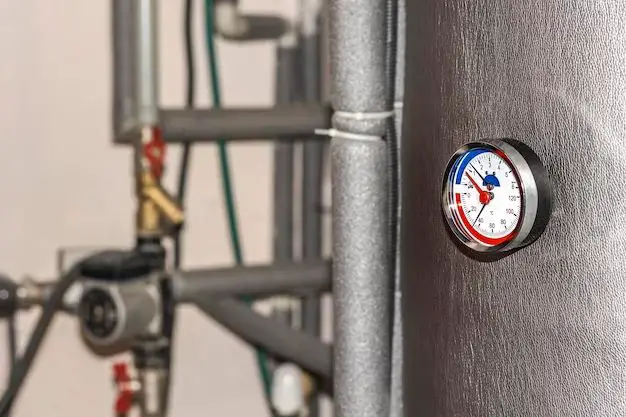The temperature gauge on a hot water heater measures and displays the temperature of the water inside the tank. It allows you to monitor the temperature setting and ensure the water heater is heating water to the correct temperature.
Page Contents
Why do hot water heaters have a temperature gauge?
There are a few key reasons why hot water heaters have a temperature gauge:
- Safety – The temperature gauge allows you to monitor the water temperature. Water over 125°F can cause severe burns instantly. The gauge lets you adjust temperature accordingly.
- Efficiency – Checking the gauge makes sure your heater is warming water to the optimal temperature. Too low wastes energy reheating water. Too high causes safety issues.
- Performance – The gauge indicates if the water heater is working correctly. Abnormal temperatures may signal problems with the thermostat or heating elements.
Where is the temperature gauge located?
The temperature gauge is usually located on the outside of the water heater tank. Common locations include:
- Control panel – Many heaters have a control panel with adjustments and a built-in gauge.
- Thermostat – Some models have a separate thermostat attached to the tank with a temperature readout.
- Side of tank – Older or more basic models may have a simple gauge affixed to the exterior side.
What does the temperature gauge look like?
There are a few common styles of temperature gauges found on hot water heaters:
- Dial gauge – Features a dial with a needle pointing to the temperature. Usually round in shape.
- Digital display – Shows the numeric temperature reading on an LCD screen. Often built into a control panel.
- Temperature windows – Has a plastic window with temperature markings. A colored indicator moves up and down to show the temp.
How does the temperature gauge work?
The temperature gauge is connected to a thermostat which regulates the water heater. Here is how it works:
- A sensor probe measures the internal tank temperature and relays data to the thermostat.
- The thermostat adjusts power to the heating elements to reach and maintain the set temperature.
- The gauge displays the temperature reading from the thermostat sensor.
- As water heats and cools, the gauge reading fluctuates to reflect the change.
How to read the temperature gauge
Reading your hot water heater’s temperature gauge is straightforward:
- Locate the gauge on the outside of the tank or control panel.
- Note what type of gauge it is – dial, digital, indicator window.
- Read the current temperature shown on the gauge display.
- Compare to the thermostat setting to see if it matches.
Typical residential temperature settings range from 120°F to 140°F. Higher temps increase risk of scalding.
What if the temperature reading is abnormal?
If the gauge shows an unusual temperature, there may be an issue with the thermostat or heating elements. Some things to check include:
- Thermostat setting – Verify it is set to the desired temperature.
- Power supply – Check that the unit is getting consistent electrical power.
- Elements – Inspect heating elements for signs of damage or mineral buildup.
- Thermostat – Test thermostat and replace if faulty.
- Sediment – Drain tank to remove built-up sediment if present.
If problems persist, contact a water heater repair professional for service.
How to adjust the temperature
Use these steps to adjust your hot water heater’s temperature setting:
- Locate the thermostat dial or controls.
- Turn dial or press buttons to reach desired temperature.
- Allow time for tank to heat to new setting.
- Check gauge to confirm new temperature is reached.
- Make small adjustments until desired temp is achieved.
Aim for 120°F to minimize safety risks. Also consider an anti-scald valve if there are small children present.
Conclusion
The temperature gauge on a hot water heater is a crucial tool for monitoring performance and safety. It displays the water temperature inside the tank and should be checked periodically. If the gauge reading is ever abnormal, inspect the thermostat and heating elements for issues. Adjust the temperature setting carefully based on your hot water needs and safety concerns.
